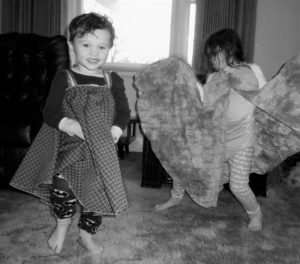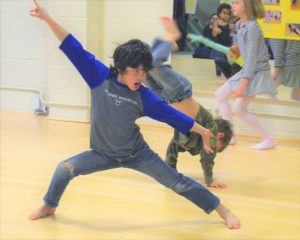I’m watching my two year old dance. He’s spinning fast, letting the full skirt of his dancing dress ripple around him, arms splayed, eyes closed. He sometimes spirals into the floor, momentum never stopping as he rolls and jumps up to spin again. Something about him tells me he’s in his zone, his flow – the repetition, concentration and intention, the fact that he can’t be interrupted, his internal focus. He only looks at me when the song ends and he exclaims, “Again!”
I ask him later about dancing. What does he like about it? He answers emphatically: “I like dancing, dress-up, running really fast!” It’s true, high speed is characteristic of his dancing because it is relatively new. Half his life he was dependent on me to move him from place to place. So now that he can go on his own, and has built up strength and confidence, he’s going fast, and it thrills him.
I watch him and imagine – or perhaps I remember – this must be what new found freedom feels like. Running through fields, rolling down hills, spinning and swirling so fast you can’t keep from smiling. Feeling the blood pulsing through your body, skin tingling as the wind rushes all over you. Nothing to stop you. He runs over to me when he’s done, wrapping his arms and legs around me in a big squeeze. I feel his heart racing against my chest; his exhilaration is palpable. I wonder, do I feel like this when I’m dancing?
It seems silly to ask. I mean, I’ve been dancing for most of my life and have chosen dance for my career, shouldn’t I feel this thrill all the time? Or have I been doing it so long that I’ve forgotten why?

I ask another expert in dance – my five year old – about why she does it. “I just like it,” she says, shrugging her shoulders. “I feel like anything when I dance. I feel like everything.” I think about how I’ve sneaked glimpses of her dancing alone, brows furrowed and lips pursed, hands carving powerfully through space, spine snaking. Or how she creates endless stage names and personas for our family dance parties. I’m often asked to introduce her with something like: “Welcome to the stage Aurora, Queen of the Moon and Stars. She’s really, really tall and powerful and has a kitten and a baby.” In her dancing, she seems to be embodying choice and identity, and a kind of omnipotence that she’s discovered in herself, in her body.
I observe kids discovering their freedom and power through dance in my teaching too. A colleague and I recently watched a video together of a creative dance class I had taught at Luna Dance Institute. After exploring lots of locomotors and shapes, I asked my students to dance however they liked. In the video they moved without hesitation – they knew exactly how they wanted to dance and just went for it. Something happened in that moment of free dance that felt substantial. We rewound the video to watch again. It wasn’t so much what they were doing, but how they were doing it. The dancers were fully embodied and smiling, internally focused and tuning into themselves, each doing their own thing so intently, and claiming their dances as their own. “Wow, they’re really in it. They’re really gettin’ it. Look at them go!” we remarked.
A student has said: “When I’m taking dance class, I just feel so able. I feel like my body can do anything; like I’m Wonder Woman or something.”
I remember saying things like that too. I feel like my best self while dancing. I come home to myself when I dance. And I remember the sensation of finding my flow, of my body channeling the message of my heart. For me it is electric, all cells listening and tingling and responding, riding a surging wave that may send me spiraling, tipping, scooping, suspending through time and space. And it may feel like . . . nothing, or everything. Emptiness and fullness simultaneously.
Why does any of this matter? Is dancing, to express my soul’s truth, just an indulgent self-serving act? Does it contribute anything to the world, the greater good? I don’t know, maybe it brings me closer to nirvana. But as I listen to the news and contemplate systems of injustice and oppression playing out in stories of #BlackLivesMatter, #metoo, school shootings, deportation, child abuse, human trafficking, I feel less and less interested in my own personal transcendence. Instead I wonder this: what if everyone could feel this free? What if everyone could feel this powerful in their bodies?
When I consider this, it shifts how I teach dance. My overarching goal now is to cultivate an environment in which students can experience freedom and express their power through their bodies. As a dance educator working in schools where children, particularly children of color, are often disciplined and controlled, I feel a sense of responsibility to nurture their freedom. I continue to wonder what does it take to do this? What do people need in order to feel the exhilaration of freedom and power in action? This is what I’ve observed so far:
- It requires a feeling of safety, so that dancers can allow themselves to be vulnerable, take risks, share something of themselves. Spending time building class community can assist with this, as can clarifying class flow and expectations, or creating a sacred container for class through a beginning and ending ritual. Even more essential is emphasizing individuality over right/wrong movement, and celebrating what each dancer brings to the class.
- It also requires a full exploration of all that the body can do, the endless possibilities of moving through space, time and energy. Plenty of chances to try again, stretch a little further, attempt it from another perspective, helps dancers trust their bodies, and their potential to express something with their bodies.
- Dancers need opportunities to create, to improvise and choreograph. There is power in making.
- And dancers need to be seen – and they need to see each other. Allowing myself time in each class to step back and witness students as they open up and claim their own power is exciting. When students witness each other in their flow, gettin’ down, and when they know that they are being seen by their peers, there is a kind of magical respect and trust established. A secret is shared, they view each other in a new way, and they can recognize and honor each other.
 There is another critical component in cultivating freedom and power in my teaching, and I’m remembering it as I watch my children. I’ve got to cultivate this within me. When I dance now, I see myself consciously practicing my freedom, stretching my power like a muscle. Because I don’t want to forget it, or take it for granted, or slip into inertia as I just go about the motions of planning my next dance class or choreograph my next piece. When I am overwhelmed by all that is happening in the world that feels so out of my control, I can do this – I can dance, and access my force, and refuse to be silent.
There is another critical component in cultivating freedom and power in my teaching, and I’m remembering it as I watch my children. I’ve got to cultivate this within me. When I dance now, I see myself consciously practicing my freedom, stretching my power like a muscle. Because I don’t want to forget it, or take it for granted, or slip into inertia as I just go about the motions of planning my next dance class or choreograph my next piece. When I am overwhelmed by all that is happening in the world that feels so out of my control, I can do this – I can dance, and access my force, and refuse to be silent.
Dance then becomes an act of resistance. History tells us that dance has long played this role, often being the first art form to be prohibited when a civilization was conquered. Complete control could not be achieved if civilians were accessing their innate creative power through dance. These days we seem to be dominating bodies in different ways: over-diagnosing and overprescribing for ADHD; reducing recess; limiting movement to sitting at desks, standing in lines, repetitive workouts at cubicle-like treadmills/yoga mats, and reducing it to the smallest possible tap, slide, click of our fingers as we stare, mesmerized into a world of screens. As a culture we remain fearful of bodies doing anything out of the ordinary. We deem it chaotic and suspicious, and react with restraint, discipline, violence, and police brutality to regain control.
So fellow dancers, fellow activists, dance on. Practice sharing your freedom with others, and invite your students and collaborators to join you. Witness each other get down, and celebrate our collective creative force as we embody resistance.
This article appeared in the June 2018 edition of In Dance.

